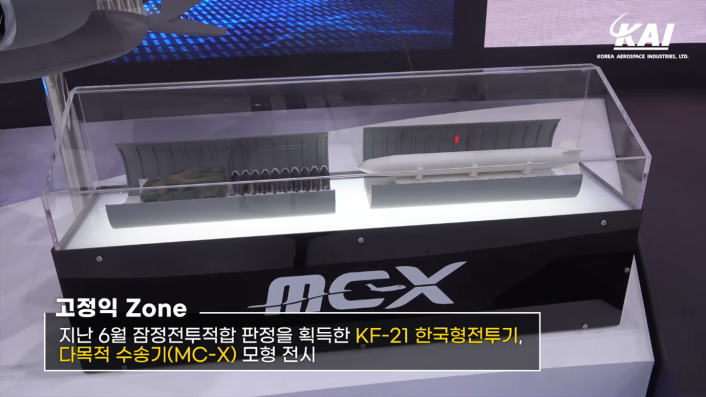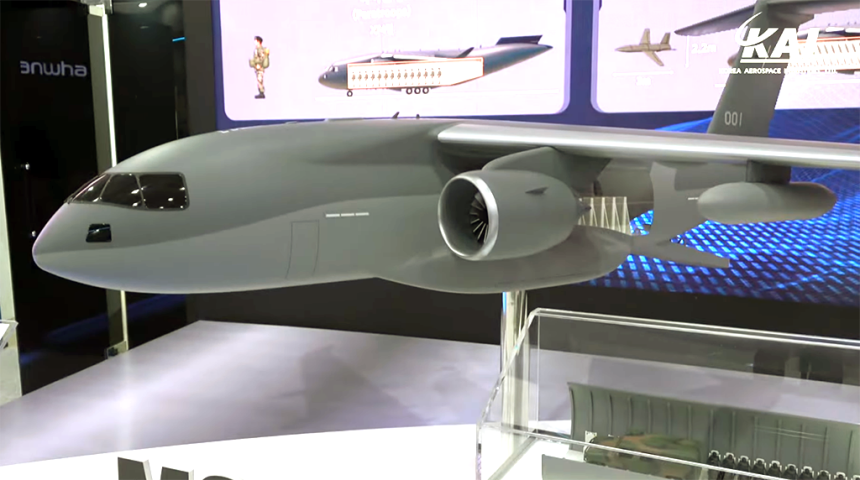South Korean firm KAI unveiled a refined roadmap for the development of the MC-X multirole tactical transport aircraft.
Last week saw Seoul’s biennial airshow, ADEX 2023, happen at the largest scale thus far. While many South Korean indigenous platforms such as the KF-21 and LAH took the spotlight, a small prototype went largely unnoticed by the general public. During the event that took place from Oct. 17 to Oct 22, 2023, Korean Aerospace Industries (KAI) unveiled its new development roadmap for its future multirole transport, the MC-X. With this, the efforts for the private firm’s commitment to the project became solid.
The MC-X is a twin engine, tactical airlift platform currently in the early design stages.
KAI has started internal development of the MC-X in 2021 in anticipation of replacing the Republic Of Korean Airforce’s (ROKAF) CN-235 and C-130H fleet. Currently the ROKAF operates a total of four C-130J-30, 12 C-130H (of which four are C-130H-30), and 18 CN-235 as their airlift force. It is currently expected that the C-130H fleet will retire in 2035 and the CN-235 to follow shortly in 2040. As of now there are no official plans set by the Ministry of National Defence to find a replacement. However, KAI seems to be eyeing on the ageing fleet and hopes that its indigenous solution will be a more attractive answer than acquiring a foreign platform.
While the first scale model of the MC-X design was unveiled at the DX Korea 2022 exhibition, several design changes have been made to the aircraft since.
Currently, the aircraft is planned as a twin jet engine tactical airlift platform with a maximum take-off weight (MTOW) of 103 tons (22,7000 lbs). maximum payload capacity of 30 tons (66,140 lbs). The cargo bay dimensions are 3.5m wide, 3.4m high, and 17m long. This will accommodate a total of 9 463L Master Pallets.
In terms of aircraft size, the airframe is expected to be in between the Embraer C-390 and Kawasaki C-2. The MC-X is set to have a range of over 7,000km, making it the longest reaching aircraft in its class. The aircraft is expected to utilise a powerplant roughly equating to the General Electric CF6. In terms of cargo, the aircraft has a capacity of 92 combat troops or 72 paratroopers. While the maximum payload weight prohibits the platform to carry the K9 howitzer, the cargo hold can house the smaller M109 based K55A1. Alternatively, the cargo hold has enough capacity for the transport of either a single AH-64 or UH-60 helicopter with its rotor blades removed.
Planned variants include a Remote Drone Carrier, Air Launched Ballistic Missile carrier, and maritime patrol variant.
It is obvious that the market that MC-X is aiming to break through is already saturated with competitors. The global market is largely dominated by the Lockheed C-130J, and an increasingly growing portion is being taken by the Embraer C-390. Even Japan’s Kawasaki C-1 and C-2 never made any sales outside the JASDF, settling at a meagre 31 and 22 airframes respectively. Thus, KAI has been looking at alternative uses for its MC-X, in hopes of increasing sales figures.
Suggested variants of the MC-X released this airshow include an air tanker, maritime patrol, an AWACS, electronic warfare platform, aerial water bomber, remote drone carrier, and most ambitiously an Air Launched Ballistic Missile (ALBM) carrier. Much like the C-130 launched Gremlin drones, KAI seems to be aiming for the MC-X to act as an aerial mothership for a smaller sized drone. Mentioned in their presentation, there are plans for deploying up to 19 150kg-class drones from the MC-X’s cargo bay.

Of all the variants, the ALBM carrier seems to be the most ambitious of projects.
Much like the previous USAF efforts of an air launched Minuteman missile, the plan is to use the platform as a solution for a rocket launcher. While the payload could become either a satellite carrying rocket or a ballistic missile, the advantages of having an air launched rocket exists for both cases. For satellites, there are many existing test cases such as the Northrop Grumman Stargazer, Virgin Orbit, and Virgin Galactic.
By achieving a higher launch altitude, the heaviest Stage 1 of a launch vehicle can be neglecting, allowing for a much cheaper launch. Furthermore, compared to ground launches, the geographic location of the launch site does not limit the orbit of a satellite as the launch vehicle can move to accommodate for the intended orbit. On top of these benefits, an ALBM platform give the missile added range for a fraction of the cost. However, the added technical complexities to such a platform, combined with the survivability of a transport aircraft on the battlefield raises the question of whether such a niche variant is really needed.
Again, another new strike missile for the South Korea?
I posted about the Air-launched ballistic missile(ALBM) or Solid propellant rocket launch system from MCX cargo plane. and now, in the ‘ADEX 2023’, the KAI showed various types of MCX types. these were, Satellite launch… pic.twitter.com/aiD9XFELWT
— ハク Mason (@mason_8718) October 21, 2023
The newly announced roadmap for the MC-X suggests that after the baseline platform is developed within 12 years of signing of an initial contract. With the ROKAF C-130H fleet expected to retire in 2035, a future transport aircraft acquisition program is expected to be launched shortly from the South Korean government. According to KAI’s development plans, the initial Block 1 MC-X will be developed purely for troop and cargo transport. The Block 2 is set to introduce multirole capability to the platform. This includes MEDEVAC pods, probe-and-drogue type aerial refuelling pods, an aerial firefighting kit, airborne UAV launcher, and air launched microsatellites. From the Block 2, different variants are planned such as a dedicated flying boom type air tanker, a UAV carrier and recovery aircraft, and combat search and rescue (CSAR).
Furthermore, considerations for modifying the fuselage have already been made. Much like the Hercules -30 variants, a stretched cargo version with extended wings are planned for a Mid Life Upgrade further down the line. Modifications to remove the rear cargo door in exchange for a Low Drag Empennage exists to allow variants for other utility variants. These include a maritime patrol aircraft, airborne early warning and control (AEW&C), airborne communications relay, signals intelligence, and a stand-off electronic jammer aircraft.
KAI signed an MoU with the UAE for co-development of the MC-X
KAI has signed a memorandum of understanding (MoU) with the UAE government to co-develop the MC-X back in January 2023. With the UAE defence and security acquisition authority Tawazun council onboard the project, efforts to develop the MC-X has become more solid. Much like the KF-X deal between South Korea and Indonesia, it appears that the South Korean firm will be in charge of the development of the aircraft and the UAE funding a portion of the project in return for technology exchange and a few airframes.
With the ROKAF having a relatively small fleet of cargo aircraft compared to the rest of its force, it appears that KAI is securing foreign sales to break even its development costs. Having watched closely the development of the neighbouring JASDF and their C-1, C-2 program, South Korea seems to have recognised the harsh reality of the global cargo aircraft market and its lower demand. More recently, the Korean government has been reaching out to Saudi Arabia for land-based weapons sales.
With relations with middle eastern customers drastically improving in the last decade, it appears the Korean government has moved outside of southeast Asia in looks of a better partner for its aerospace division as well. In short, the global medium sized airlift market is soon to expect yet another competitor in the coming decade. However, how much traction the private firm’s project will gain within the Korean government is yet to remain in question.









